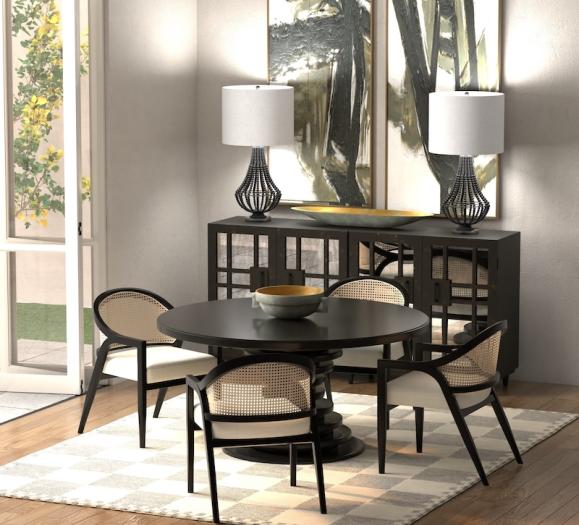This week, Williams-Sonoma Inc. filed a lawsuit in Northern California against Amazon.com Inc., alleging the mega-retailer had copied patented chair designs and engaged in unfair marketing practices online.
If you thought following the U.S. Supreme Court case on sales tax earlier this year was interesting, just wait. There's a lot to unpack with this lawsuit, and it could have an important impact on the furniture industry as well as e-commerce.
Let's dive in.
What's in the lawsuit?
Williams-Sonoma's lawsuit alleges that Amazon copied its Orb and Slope chair designs sold by West Elm, all of which Williams-Sonoma had a patent on, and sold them under its Rivet private label collection. West Elm is owned by Williams-Sonoma. The lawsuit further states that the Rivet label itself is a knockoff of West Elm products and that the label infringes on Williams-Sonoma's design patent and trademark rights.
So this is about a chair design? Not quite.
Williams-Sonoma is claiming that Amazon competes unfairly with Williams-Sonoma online. The complaint states that Amazon uses Williams-Sonoma's "federally-registered incontestable service mark" on its website and in direct email marketing campaigns "that promote Amazon’s own online retail services as well as directly fulfilling orders for putative WILLIAMS-SONOMA products." Further, these actions have caused some confusion with consumers who believe that they're getting a Williams-Sonoma product and are disappointed with products that "are not subject to WSI’s quality control measures, and/or have been damaged or altered such that the WILLIAMS-SONOMA mark no longer properly applies."
This lawsuit asks two questions: Did Amazon copy this chair design and did it engage in unfair marketing practices, leading consumers to believe that these products were connected with the Williams-Sonoma name?
Furniture designs and patents
You don't have to be a legal expert to see that these two chairs do look alike (you can see the two chairs here). But if you go to enough markets and tour enough showrooms, then it's likely that you'll see similar chairs and furniture designs in more than one showroom. So why is it then that the courts aren't packed with these types of lawsuits, and for that matter, which lucky company has a patent on the classic chair design?
It's more complicated than that.
"Furniture designs are protectable if they meet the rules governing protections of all inventions, furniture or otherwise," says Jack Hicks, a partner and lawyer at Womble, Bond and Dickinson in Greensboro, NC, who's been working with home furnishings industry for 30 years.
While no company can apply for a patent on just a chair (four legs, seat and back), Hicks describes patents on furniture designs as "baby steps, not big leaps," meaning the patents are usually for small, but important details in design. This could be, he elaborates, anything from where the legs are placed, where the border is or how loose or fixed the backrest is.
Getting a patent for a furniture design isn't impossible, but there's a lot of work that goes into it. After it filed for a patent with the U.S. Patent Office, Williams-Sonoma had to swear to the office that the designer was the one true creator of it and that the design itself was novel or new over what's come before it — then they had to prove it. When determining whether to grant a patent or not, the U.S. Patent Office looks at previous designs and patents to determine what's truly new and novel and worthy of protection. It's not easy to prove, and especially with chair designs, there's not a lot that's new at this point.
The patent office decided that the design was new and granted Williams-Sonoma its patent in 2016. Amazon's Rivet Collection came out in or around November 2017, but that doesn't make this an open-and-shut case. Hicks says a jury may determine that the patent was mistakenly granted and throw it out, thus negating this portion of the case. The jury could also decide that the chairs don't look similar enough. We'll have to wait and see.
In the past, Amazon has avoided prosecution for selling counterfeit goods because it claimed to be just the platform, not the seller. With Rivet being its own private label, Hicks says Amazon probably won't be able to use that same defense, which could impact how Amazon does business.
Is that Amazon or Williams Sonoma?
The second portion of this case deals with fair online competition. Essentially, Williams-Sonoma is claiming that Amazon's web pages and emails use Willaims-Sonoma's mark and design in order to imply that the products were either sold by Williams-Sonoma through Amazon or that Amazon is an authorized Williams-Sonoma retailer.
The complaint supplies screenshots of product pages on Amazon that appear to be sold by Williams-Sonoma, including the "By Williams-Sonoma" label at the top and going so far to create a "Shop Williams-Sonoma" page. The page looks like an authorized shop, according to the complaint, and circles drawn on the screenshots highlight what Williams-Sonoma's complaint called copyrighted photography. All of this, the complaint alleges, confuses consumers.
Further, the complaint provides a copy of a marketing email sent to Williams-Sonoma President Janet Hayes with the subject line: "Janet: Williams-Sonoma Peppermint Bark 1 Pound Tin and more items for you." The 1-pound tin mentioned in the subject line is listed in the email as being twice the price of what it is on Williams-Sonoma's site, implying that Amazon's other selected products would be a cheaper option than this tin says the complaint.
The complaint alleges that Amazon is basically trying to capitalize on Williams-Sonoma's name and deliver a sort of bait-and-switch. Consumers think they're getting Williams-Sonoma when they're not, and consumers are falling for it. The complaint mentioned an irate customer who visited a Williams-Sonoma store and asked why the brand was selling on Amazon.
So is any of this legal?
Hicks explains that courts have allowed online competitors to gently copy one another in the name of fair competition. For example, he says, companies can buy keyword ad space for competing companies so long as ad is clearly marked as sponsored or otherwise identified as an ad. This is done so as not to confuse searchers. Whether or not Amazon's use of the Williams-Sonoma mark falls into fair competition category will be up to the courts to decide.
The outcome of this case could have an impact on furniture design patents as well as online competition. What about this case interests you the most? Share with us in the comments!







